Antinol® Latest Studies
Sorted by recent
 Filter Studies by Smart Tags
Filter Studies by Smart Tags
Bone & JointCardiovascularCase Study & ProceedingCatDogEAB 277™EfficacyExotic PetImmunologyNeuro & BehaviorOphthalmologyOralRabbitRenalRespiratoryRodentSafetySkinUTI
Smart Search
Use of PCSO-524® for Supplementary Treatment of Protein Losing Nephropathy in Animals

An intact male Shih Tzu dog weighed 5.8 kilograms was referred to Suvarnachad Animal Hospital with signs of polydipsia, polyuria, edema and ascites due to accumulation of fluid in the abdominal cavity.
Biochemical tests found hypoalbuminemia, hyperglobulinemia, hypercholesterolemia, increased urine protein creatinine ratio (UPC) to 5.88 and no signs of inflammation or infection of the urinary tract.
Protein losing nephropathy from glomerular disease was diagnosed based on the biochemical indicators. Medication was given to the dog in order to control kidney damage and minimize the clinical symptoms.
Anti-proteinuric drug, for example ACE inhibitor to reduce blood pressure, was particularly selected for the treatment in conjunction with prednisolone and PCSO-524® as supplementary treatment.
During the 10 months follow up, the dog showed improvement of clinical symptoms, no edema, lack of accumulation of fluid in abdomen cavity, and serum albumin that was increased to normal level.


Report Clinical Results of Feline Patients with Chronic Kidney Disease (CKD) that received PCSO-524® Vol.10 (2019 February)

Chronic Kidney Disease in cat(2) treated with Antinol®
Mongrel Cat, 7 years old was admitted to Maizuru Animal Medical Center, Kidney disease was observed.
Overview: Patient was repeatedly hospitalised for treatment of CKD. But two weeks after Antinol® was added to treatment regimen, decrease in BUN, Are, and P level as well as improvement of appetite and activity was observed.
(Addition of Antinol® to treatment: 1st 2 weeks; 2 caps / day, orally. Continued with 1 caps / day, orally for 1 week. Increased dose in the 4th week to 2 caps / day, orally since appetite decreased.)

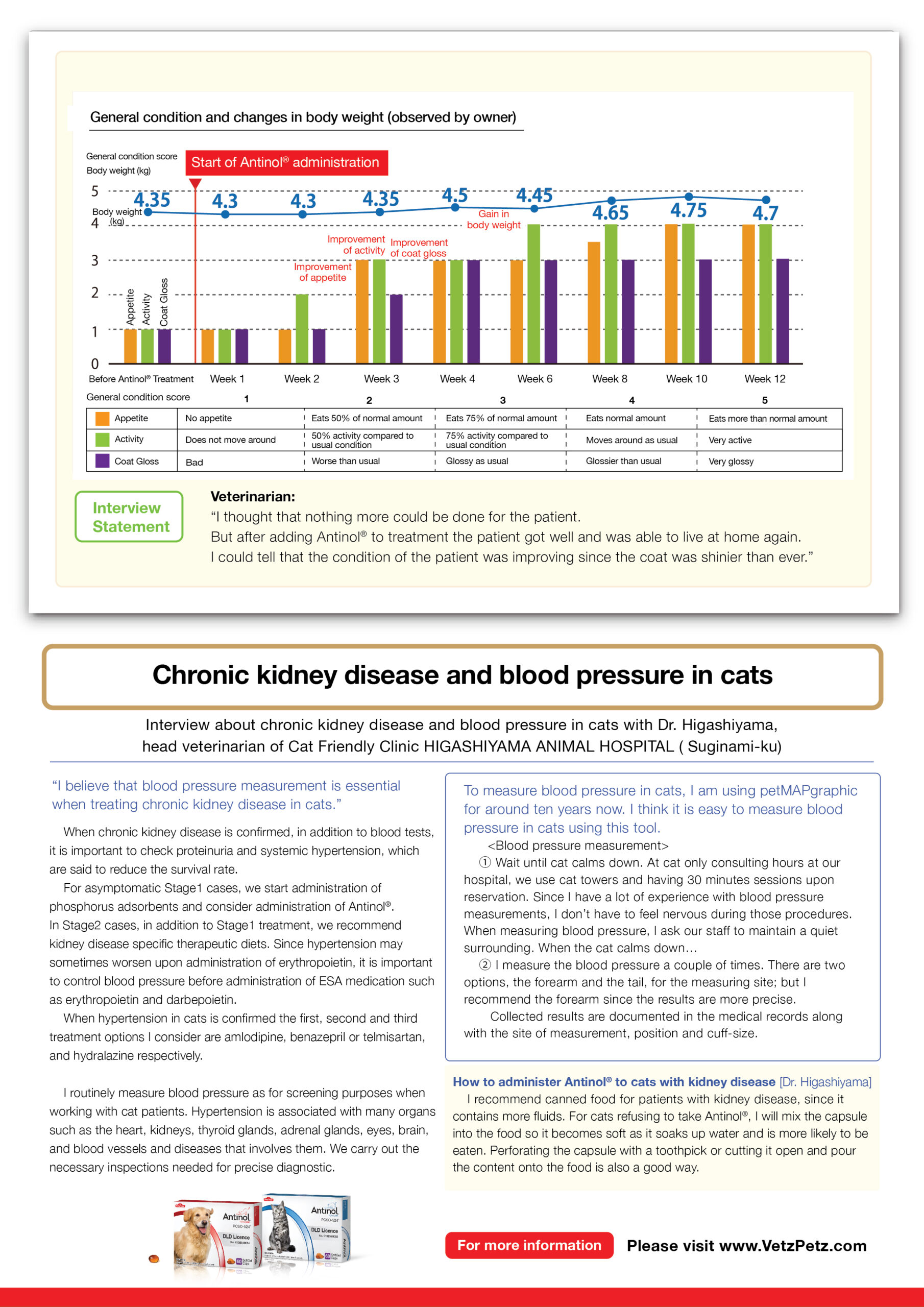
Report Clinical Results of Feline Patients with Chronic Kidney Disease (CKD) that received PCSO-524® Vol.9 (2018 September)

Chronic Kidney Disease in cat(1) treated with Antinol®
Mongrel Cat, 7 years old was admitted to Maizuru Animal Medical Center, patient was diagnosed with CKD
Overview: Patient was not responding to treatment but decrease in BUN and Creatinine (Are) levels were observed after Antinol® was added to treatment regimen.
(Addition of Antinol® to treatment: 1st 2 weeks; 2 caps / day orally. Continued with 1 caps / day orally.)

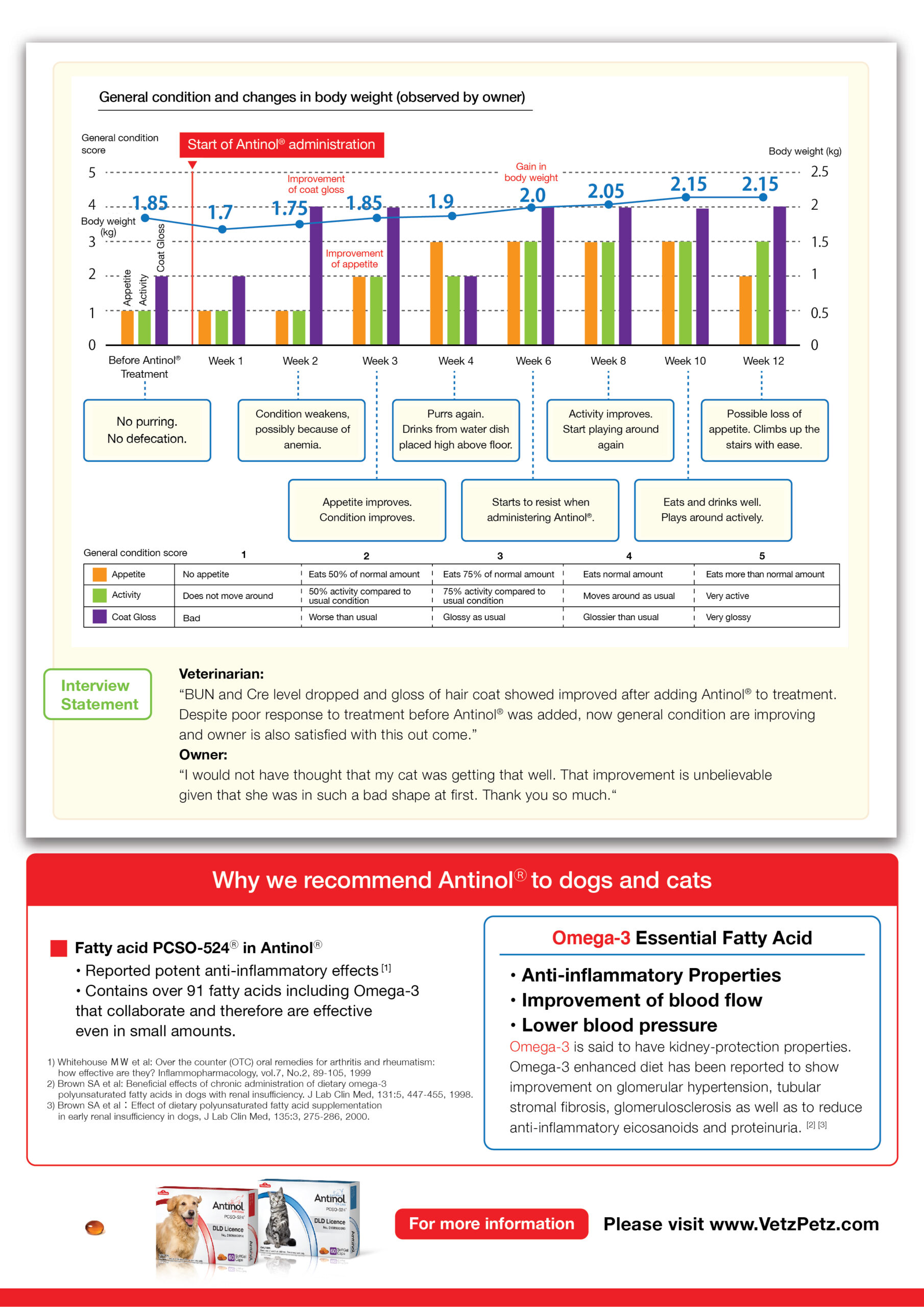
Use of PCSO-524® Along with Physical Therapy for Controlling Pain and Inflammation in a Cat Suffering from Osteoarthritis, Chronic Kidney Disease and Triaditis

A spayed female domestic shorthaired cat aged 21 years and weighed 4.2 kilograms with history of chronic kidney disease and triaditis was referred to Suvarnachad Animal Hospital.
The cat showed signs of both hind limb weakness, limp tail and pain around posterior body part. Other signs included polydipsia, polyuria, and diarrhea. Radiographic examination revealed osteoarthritis at lumbosacral joint, elbow and both stifle joints. Hematological and blood chemistry tests showed mild anemia, neutrophilic leukocytosis, increased serum amyloid A and Increased Feline pancreatic lipase.
Administration of PCSO-524® and physical therapy were provided to reduce systematic and local pain and inflammation. The supportive treatment was continued for 15 months, during the first 2 months of which, the lumbosacral joint painwas reduced and then disappeared after 5 months. The control of elbow and knee joint pain was satisfied for the whole treatment period.
The cat was able to move the tail and resume normal walking after the 1st and 5th month of the treatment, respectively. Ability to jump and climb returned in the 5th and 8th month. However, the cat had improved defecation within 3 months. Testing of feline pancreatic lipase and serum amyloid A showed normal levels after 7 months of the treatment.
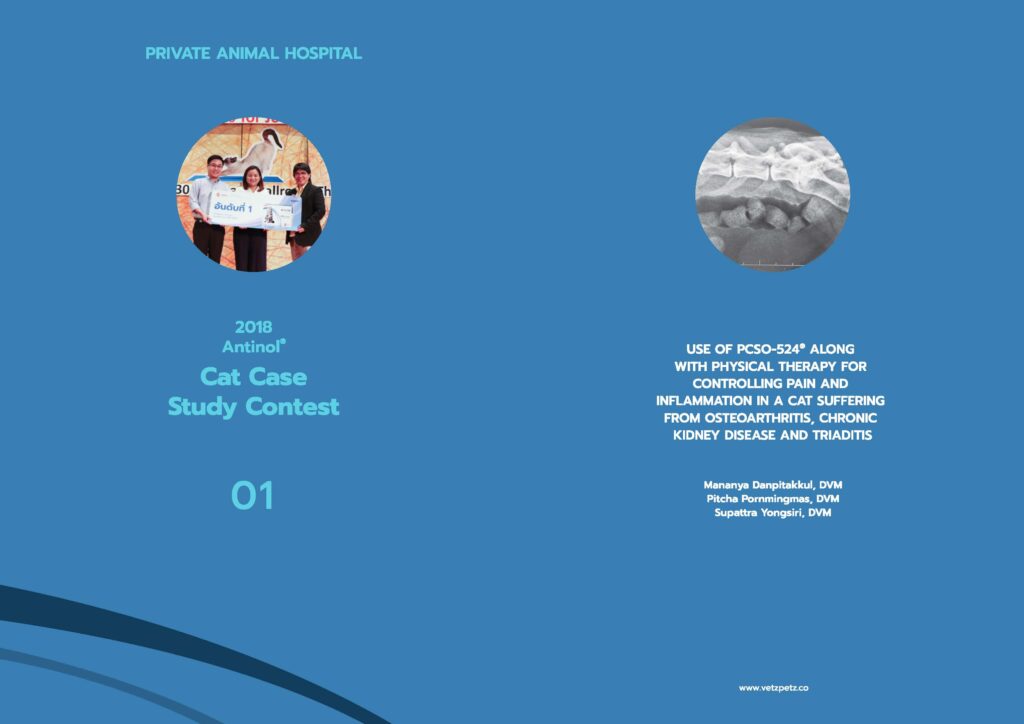
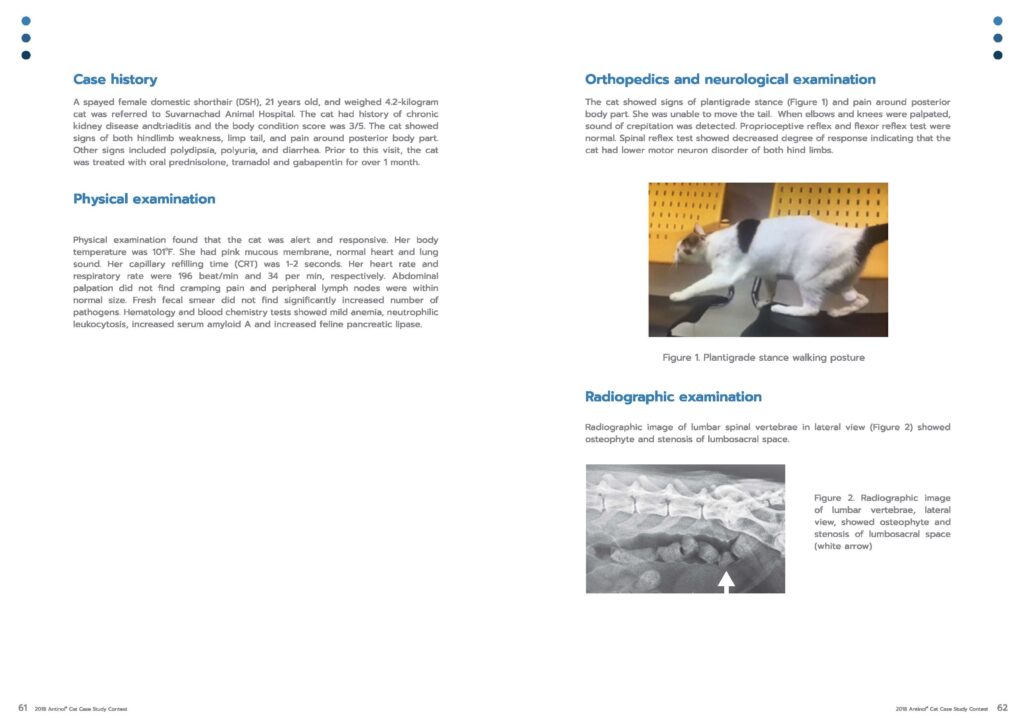
Use of PCSO-524® for Control of Inflammation Caused by Iris Tumorand Uveitis in Cats with Lymphoma and Chronic Kidney Disease

A neutered male Domestic Shorthair cat aged 8 years was infected with FIV and diagnosed with nasal submucosa-T-cell lymphoma that was positive to CD3.
Four months later, tumor of iris and uveitis were found in the left eye. Treatment of inflammation of the left eye included prednisolone acetate 1% eye drop (lnf-oph® 1 %, Seng Thai company; Thailand) qid, doxycycline (Siadocin®, Siam Bheasach; Thailand) PO at the dose 10 mg/kg/day, prednisolone (Prednisolone GPO; Thailand) PO0.36 mg/kg bid.
Two weeks later, the size of tumor remained constant, the inflammation degree was reduced but creatinine level was increased. Administration of oral prednisolone, not the eye drop, was then terminated. Uveitis of the right eye was diagnosed and also fibrin in the anterior chamber and tumor of the iris were found in the right eye. Prednisolone acetate 1% eye drop was prescribed for both eyes.
The inflammation of both eyes still existed after 1 month of the prednisolone treatment. Green Lipped mussel extract, PCSO-524® (VetzPetz Antinol®, DKSH, Thailand), 1 capsule per day was then prescribed as an alternative of steroidal medication for control of inflammation, together with the prednisolone acetate 1 % eye drop in both eyes.
After 30 days of the start of PCSO-524® treatment, the tumor of iris disappeared and the severity of uveitis was reduced in both eyes.
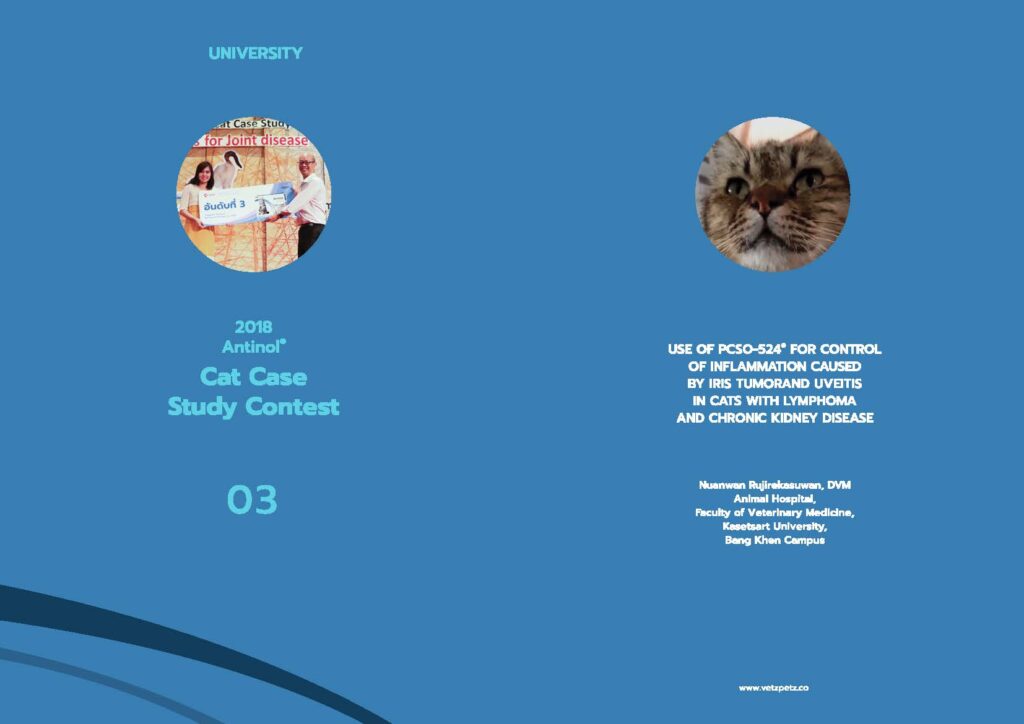

Effects of PCSO-524® (Antinol®) Supplementation during 12 Months Follow-up in 2 Cats with Cystitis and Chronic Renal Disease

Two female cats, spayed, lived in the same house, aged 17 years weighted 2.2 kg and 10 years 4.4 kg, were having chronic renal failure and concurrent cystitis.
Both cats were treated with fluid therapy intravenously in the early period and later subcutaneously. The diet was changed to diet formulated for cats with renal failure (Hill’s Prescription diet k/d) for both cats. Avastamine (RenAvastTM) 1 capsule bid for 1 month, Cystaid® cat (Acetyl 0-Glucosamine: NAG125 mg) l capsule bid for 1 month, and PCSO-524® (Vetz Petz Antinol®) 1 capsule sid continuously were prescribed for the first cat. The second cat received only PCSO-524® (Vetz Petz Antinol®) 1 capsule sid continuously.
The treatment results showed general health improvement, weight gain (2.6 kg and 5.1 kg in the first and second cat, respectively), less hair loss, decreased degree of polydipsia and polyuria, and improvement of blood parameters.
No adverse effect of the continuous treatment was found after 18 and 13 months in the first and second cat, respectively.


Effects of PCSO-524® on Inflammation Control in Cats with Chronic Renal Disease after Keratectomy and Conjunctival Pedicle Graft for Treatment of Corneal Sequestrum from Indolent Ulcer

A female spayed cat aged 13 years with chronic renal disease later affected with indolent ulcer, and consequently followed by corneal sequestrum.
After azotemia was controlled, the cat was surgically treated with keratectomy that used conjunctival pedicle graft for suture closure.
The cat received 4mg/kg Tolfenamic acid (Tolfedine®, Vetoquinol, Best Agro; Thailand) for 3 days, 2.5 mg/kg Doxycycline monohydrate (Vibravet®, Zoetis, Thailand) for 2 weeks and 1 tablet per day of New Zealand Green-lipped mussel extract, PCSO-524® (Vetz Petz Antinol®, DKSH, Thailand) for long-term control of inflammation.
The latter was used as an antioxidant and alternative to Non-steroid, which is a contradiction for chronic renal failure.
The cat showed decreased severity of inflammation, normal clinical symptoms, and fine control of azotemia.
It is concluded that PCSO-524® (Vetz Petz Antinol®) can be used to support long-term anti-inflammation treatment and reduce the damage in cats with medical contraindication due to chronic renal disease

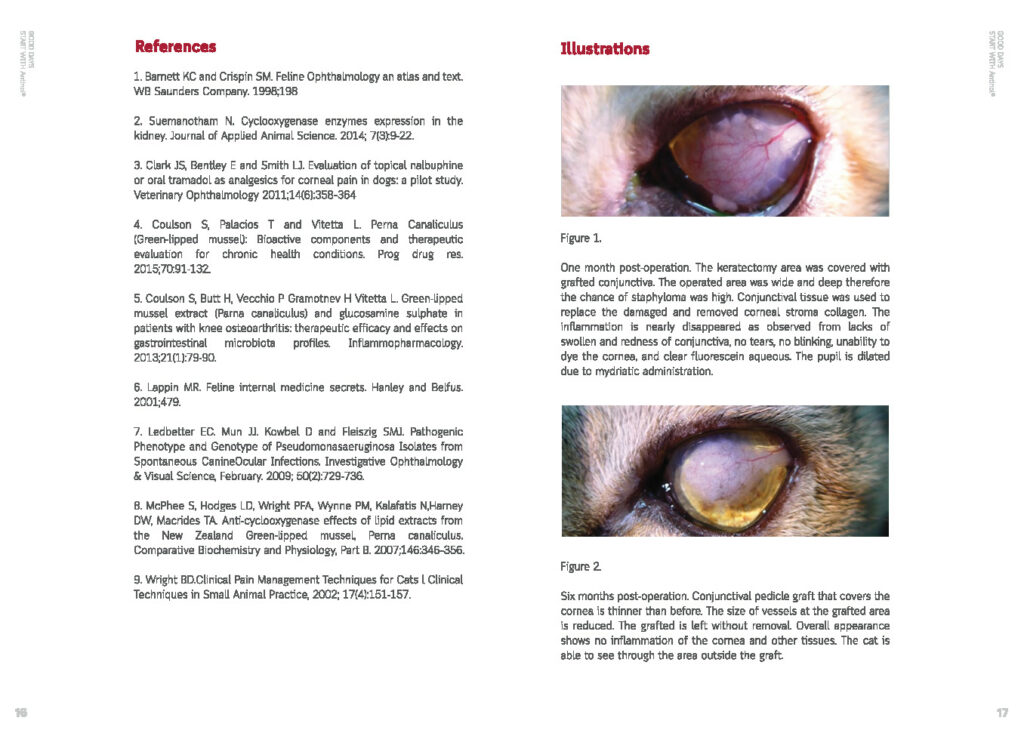
Updated Study Topics
New researches and publications related to PCSO-524® and its result in clnical test submitted by veterinarians on the global conferences every year and the data keeps growing with more studies conducted


 Authors:
Authors: